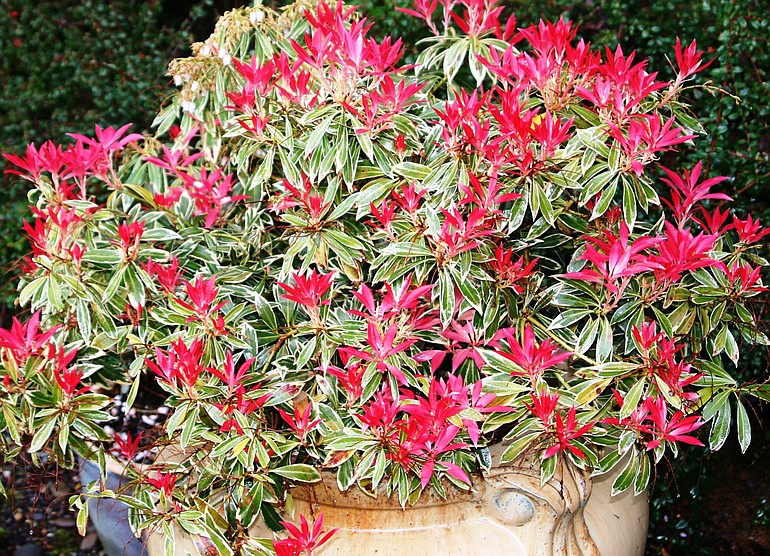When I think about winter garden preparation, I invariably remember the times that I did not prepare for inclement weather. I will never forget the winter I decided to leave two intricately branched weeping Japanese maples in decorative planters on either side of the barn doors. One night, a foot of snow accumulated on the barn roof. The next morning was bright and clear, a delightful winter day was in the making.
The barn roof was made of metal and the combination of slanted roof, heavy snow and bright sunshine had the aerodynamic effect of an alpine ski jump. An alpine ski jump without a lift at the end of the run. When the snow slid off the roof in one fell swoop, it took both maples with it. Now, I always move potted plants from under the eaves of the house or barn in mid-November.
• Making room for evergreens.
When it comes to choosing plants, nothing lends texture, volume and visual depth to a planting design than evergreens. Winter is the time of year to evaluate the skeletal structure of the garden. Now is the time to decide if a conifer, rhododendron or winter-hardy cotoneaster will add interest to a specific area of the garden in the winter season. Groups of evergreen shrubs form walls, divisions and backdrops. Evergreen shrubs and trees connect the earth and sky and bring your home into scale with your garden.
Bold sweeps of evergreen ground-cover plants such as euphorbia, pachysandra or vinca threading through beds and borders are important in unifying the winter garden. Keep in mind that the term “evergreen” is a general description for a plant that holds its leaves throughout the year. This includes plants with needles such as pine and fir, as well as broadleaf evergreens like rhododendron and pieris. In addition, evergreens come in shades of blue, gold, yellow and red.
• Selecting silhouettes.
Since I often advocate choosing certain plants for their winter silhouette, it makes sense to remove any branches, limbs or debris that detracts from the architecture of the plant. The Kilmarnock willow (Salix caprea) is a small, weeping form of willow, with a multitude of distinctly arching branches. Because of its intricate branch structure, dead leaves and windblown debris get caught in the branches before falling to the ground. Pick these out of the tree so you can clearly see the inherent structure of the plant.
Stewartia is another tree with a distinct pattern of branching. As the tree matures, the branches continuously grow away from each new leaf bud. This gives each branch a gentle zigzag pattern. In the midst of winter, the effect is one of graceful undulation. Occasionally, the seedpods left after summer flowering will hold on through winter. You can improve the overall look of the tree in late winter if you remove any seedpods that have become moldy or deformed from winter rains.
Include other deciduous shrubs with unique growth patterns to enhance your winter garden. The “Shasta” viburnum is distinctly horizontal with branches that grow off the main stem in neatly divided layers. For a mass of interesting twists and turns, plant the contorted filbert, Harry Lauder’s Walking Stick (Corylus avellana “Contorta”). The winter blooming witchhazels Hamamelis mollis and H. intermedia grow up and out from a central trunk, creating a large, vaselike silhouette.
• Convenient pruning.
A few years ago, when I had more roses in the garden than I do today, I read a magazine article that put proper rose pruning to the test. It recommended that we do the first seasonal pruning of any shrub roses with a pair of hedge clippers, not pruners. You simply cut the plant down to about two and a half feet and you are finished. The report confirmed that there was no discernible difference between this method of pruning and choosing to cut specific branches at distinct points on the branch with a proper pair of secateurs.
This approach is especially convenient if you are pruning a variety of hedge or landscape roses. I had great success with this method on the low-growing shrub rose, “Gourmet Popcorn.” At one time, I had more than 25 of these roses and it was a great stress reducer knowing I did not have to do my job perfectly for the plant to do its job.
I am no longer willing to trim any plant two or three times a year, so I replanted with a tidy hedge of Japanese Box Holly (Ilex crenata spp.). Still, I do miss that sweet, old-fashioned, honey scent wafting through the summer garden.
Robb Rosser is a WSU-certified Master Gardener. Reach him at Write2Robb@aol.com.



